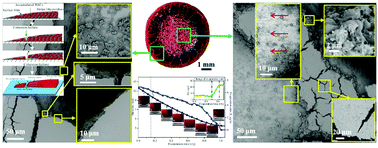当前位置:
X-MOL 学术
›
J. Mater. Chem. B
›
论文详情
Our official English website, www.x-mol.net, welcomes your feedback! (Note: you will need to create a separate account there.)
Understanding desiccation patterns of blood sessile drops
Journal of Materials Chemistry B ( IF 7 ) Pub Date : 2017-10-30 00:00:00 , DOI: 10.1039/c7tb02290e Ruoyang Chen 1, 2, 3 , Liyuan Zhang 1, 2, 3 , Duyang Zang 4, 5, 6, 7, 8 , Wei Shen 1, 2, 3
Journal of Materials Chemistry B ( IF 7 ) Pub Date : 2017-10-30 00:00:00 , DOI: 10.1039/c7tb02290e Ruoyang Chen 1, 2, 3 , Liyuan Zhang 1, 2, 3 , Duyang Zang 4, 5, 6, 7, 8 , Wei Shen 1, 2, 3
Affiliation

|
Desiccation of a blood sessile drop on a glass surface leads to the formation of interesting cracking patterns. These desiccation patterns have been identified to have three characteristic regions, i.e., peripheral, coronal and central regions. Driving forces responsible for the formation of cracking patterns are the redistribution of colloidal materials driven by a “coffee ring” effect and the time- and location-dependent development of internal stresses caused by water evaporation and progressive gelation from the drop edge to its center. Since the concentrations of colloidal materials, i.e., cellular components, protein macromolecules and other constituents (glucose, bilirubin and lipids) in blood, influence the cracking patterns, an understanding of these patterns can potentially reveal clues for the evaluation of health conditions and offer a low-cost diagnostic tool for human diseases. This study presents a mechanistic analysis of the pattern formation in desiccating blood sessile drops. We focus on the build-up and release of internal stresses by examining the cracking process. Optical and scanning electron microscopes (SEM) were used to capture the initiation, propagation and directions of cracks in different regions. The propagation and widening of orthoradial and radial cracks in relation to the adhesion and cohesion of the blood sessile drops were observed and characterized. New microscopic insights into internal stress releasing processes provide a new understanding of physical events occurring underneath the gelled film of the blood sessile drop and differences in the distribution of strain energy in different regions, which will aid our understanding of different cracking patterns in those regions.
中文翻译:

了解血无滴剂的干燥模式
在玻璃表面上的无血小滴的干燥导致形成有趣的破裂图案。已经确定这些干燥图案具有三个特征区域,即,外围,冠状和中央区域。形成裂纹模式的驱动力是由“咖啡环”效应驱动的胶体材料的重新分布,以及由水分蒸发和从液滴边缘到其中心逐渐凝胶化而导致的内应力的时间和位置相关的发展。由于胶体物质的浓度,即,血液中的细胞成分,蛋白质大分子和其他成分(葡萄糖,胆红素和脂质)会影响裂解模式,对这些模式的了解可能会揭示出评估健康状况的线索,并为人类疾病提供低成本的诊断工具。这项研究提出了干燥无梗血滴的模式形成的机理分析。通过检查开裂过程,我们专注于内部应力的建立和释放。使用光学和扫描电子显微镜(SEM)捕获不同区域中裂纹的萌生,传播和方向。观察和表征了与径向无柄液滴的粘附和内聚相关的正径向和径向裂纹的扩展和扩展。
更新日期:2017-11-08
中文翻译:

了解血无滴剂的干燥模式
在玻璃表面上的无血小滴的干燥导致形成有趣的破裂图案。已经确定这些干燥图案具有三个特征区域,即,外围,冠状和中央区域。形成裂纹模式的驱动力是由“咖啡环”效应驱动的胶体材料的重新分布,以及由水分蒸发和从液滴边缘到其中心逐渐凝胶化而导致的内应力的时间和位置相关的发展。由于胶体物质的浓度,即,血液中的细胞成分,蛋白质大分子和其他成分(葡萄糖,胆红素和脂质)会影响裂解模式,对这些模式的了解可能会揭示出评估健康状况的线索,并为人类疾病提供低成本的诊断工具。这项研究提出了干燥无梗血滴的模式形成的机理分析。通过检查开裂过程,我们专注于内部应力的建立和释放。使用光学和扫描电子显微镜(SEM)捕获不同区域中裂纹的萌生,传播和方向。观察和表征了与径向无柄液滴的粘附和内聚相关的正径向和径向裂纹的扩展和扩展。



























 京公网安备 11010802027423号
京公网安备 11010802027423号